In graphics: What progress has been made in Haiti?
- Published
The 7.0 earthquake that struck Haiti on 12 January 2010, killed more than 250,000 people and affected almost four million.
The humanitarian response and reconstruction programme has been an exceptional challenge. Already made difficult by the destruction of government institutions and widespread poverty, it was further complicated by an outbreak of cholera in October and a prolonged period of political instability following the November 2010 elections.
Critics have attacked the lack of progress made by the Haitian state and the international community in the country's reconstruction. So, how much money has been raised in the last 12 months, how much has been spent and what has actually been achieved so far?
Funding
By December, donors had provided just over $1bn of the $1.5bn required for quake relief and recovery, the UN Organisation for the Coordination of Humanitarian Affairs, external (OCHA) has said.
This has meant many areas have been under funded.
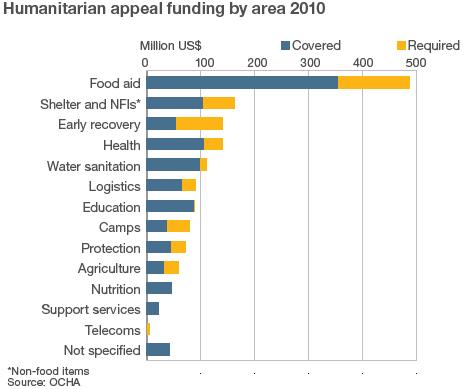
In 2011, the UN has said it will be seeking an additional $906m to help Haiti. This funding will include cash to deal with the cholera outbreak.
In addition to the humanitarian appeal funds, at a conference in New York in March last year, international donors pledged $2.01bn for the country's long-term recovery.
However, just $1.28bn - or 63.6% - was disbursed by the end of December, according to the Office of the UN Special Envoy to Haiti, external, former US President Bill Clinton.
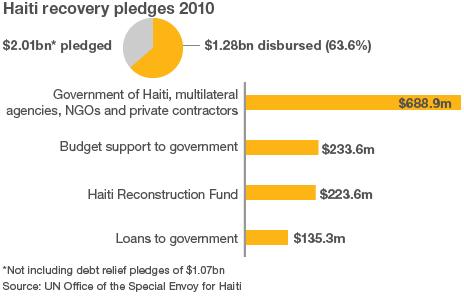
Of the $4.46bn pledged for both 2010 and 2011 combined, just 28.7% has been disbursed, Bill Clinton's office says.
Shelter
After the quake, 2.3 million people were forced to leave their homes. A total of 188,383 buildings collapsed of which 105,000 were completely destroyed, according to the UN Development Programme, external.
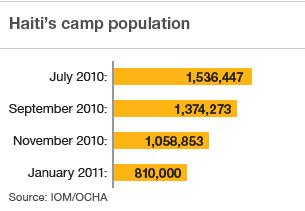
At the peak, 1.5 million people were living in 1,354 spontaneous settlements, or camps, according to the International Organisation for Migration, external (IOM).
This month, the number of people living in camps has dropped to 810,000, the IOM says.
In addition, 31,656 transitional shelters - sturdier structures than tents - have been constructed, providing 158,000 families with safer living conditions, according to OCHA.
Water and sanitation
Following the disaster the focus of the relief effort was to bring safe water and sanitation to those who had been displaced. Since then, NGOs have acknowledged that the challenge of building sustainable long-term solutions is more difficult.
Unicef, external says that so far, more than 15,000 latrines have been set up serving one million people, but admits in its one-year-on report that the unpredictable movement of populations, land-rights issues and changing strategies, has meant that installing latrines and upgrading sanitation in temporary sites has been a "major challenge".

Following the cholera outbreak, extra funding has also been channelled into promoting hygiene in schools and communities.
Health
Much of Haiti's health system was hit by the quake. Eight hospitals were destroyed and 22 seriously damaged - more than half of the 49 hospitals in the three regions affected.
In the immediate aftermath, the focus was on saving lives and at least 4,000 emergency amputations were carried out.
But 12 months on, cholera has become the major health challenge. According to Unicef, by the end of December, the disease had spread to all of Haiti's 10 regions, or departments.
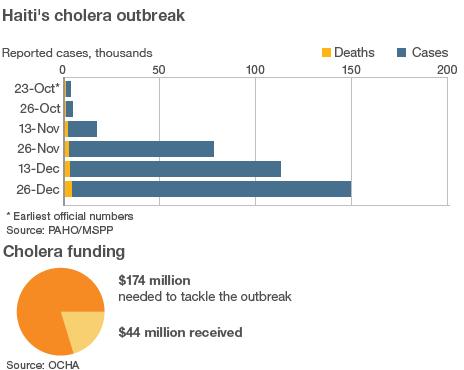
OCHA asked donors for extra money to deal with cholera in November as health workers rushed to halt the fast spread of the disease.
Medecins Sans Frontieres also say that despite the huge aid agency presence in Haiti, the urgent needs of cholera sufferers are not being met.
Children and education
Some 750,000 children were directly affected by the quake, according to Unicef.
A total of 5,058 children were separated from their parents or guardians. Of these, 1,303 have been reunited with their families, OCHA says.
In education, almost 3,000 temporary tent schools have been set up, while 298 semi-permanent schools have been built, Unicef says. A further 112,300 children have access to 437 child-friendly spaces - places where children can go to feel safe.
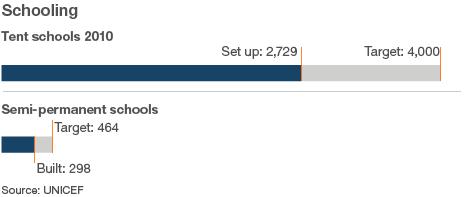
Unicef says 1.9 million children have also been immunised against major vaccine-preventable diseases.